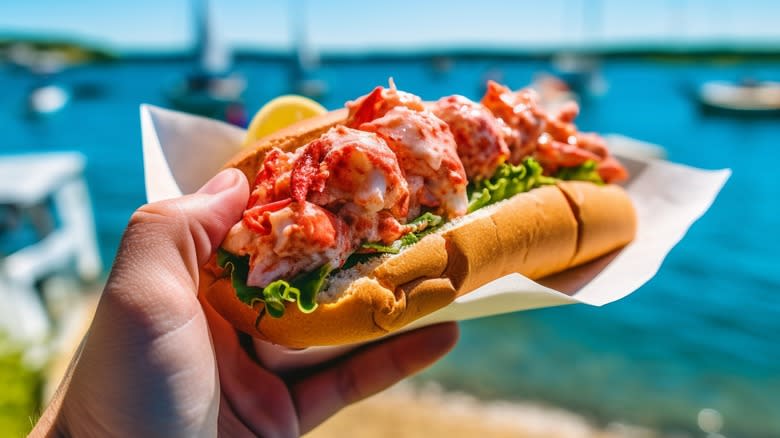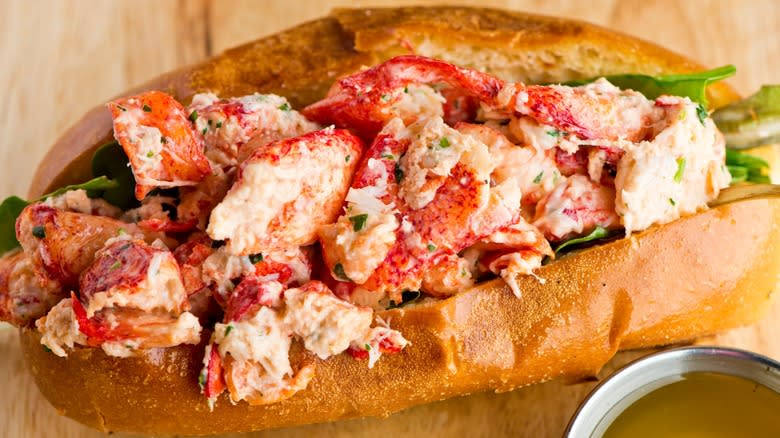Perry's Restaurant In Connecticut Is Where The Lobster Roll Was Invented

From Red Hook Lobster Pound in Brooklyn to Ironside in San Diego, foodies across North America are all about lobster rolls. Whether you enjoy 'em out of a beachfront food truck or at a Michelin-starred restaurant (you can even make 'em at home), lobster rolls are the summertime staple sandwich with small-town roots. Like many of the most timeless, craveable developments in culinary history, lobster rolls were started by home cooks who didn't have a lot of money. (Tuscan cucina povera enthusiasts, rise up.)
Deliciousness aside, they have a pretty straightforward, unglamorous assembly: white bread, butter, and lobster meat. If you're a New England fisherman, then lobster is an ingredient to which you have easy access. The original American colonists who landed on Plymouth Rock considered lobster to be the protein of poor men due to its local abundance. Lobster wouldn't become a delicacy ingredient until later on.
It's probably no surprise that lobster rolls are native to the Northeast, but per the lore, they first started cropping up in Connecticut, particularly the Cape Cod region. It all started in 1929 at Perry's restaurant in Milford, Connecticut, when a traveling liquor salesman strolled through. The famished nomadic merchant was in dire need of a portable sandwich (liquor sales stop for no man, not even a hungry one), so Perry's owner Harry Perry (great name) whipped up a hot grilled lobster sandwich to feed the man's particular needs. And baddabing, baddaboom, the lobster roll was born.
Read more: Restaurant Foods That Always Taste Better Than What You Make At Home
The Lobstah Roll Cometh

Is the restaurant's claim to fame legit? The "Encyclopedia for American Food and Drink" by John Mariani (via the CT Post), says that lobster rolls "may well have originated at a restaurant named Perry's in Milford, where owner Harry Perry concocted it for a regular customer named Ted Hales sometime in the 1920s." Perry's even had a sign out front until 1977 that read "Home of the Famous Lobster Roll." Per the story, Perry's also enlisted the help of nearby French's Bakery in Bridgeport, Connecticut, to create a crusty bread that wouldn't become soggy too quickly under the butter and warm meat.
Whether or not the liquor salesman existed seems irrelevant. Lobster rolls rock and good news travels fast. By the 1950s, the entire New England coastline was serving up lobster rolls. Iconic Boston chef Jasper White was the first to make them "upscale" in the '80s, and in 1996, they were on the menu at Pearl Oyster Bar in Greenwich Village, NYC. Pearl's Chef Rebecca Charles is credited with launching the lobster roll nationwide, making it an "in" food item beyond Northeast shores.
Today, there are two unofficial types of the iconic seafood sandwich duking it out: Maine versus Connecticut lobster rolls. Maine-style rolls contain cold lobster salad dressed in mayonnaise sauce, lemon juice, and seasonings. Connecticut-style lobster rolls are served warm and dripping with butter. And a proto-lobster roll "the Milford way" serves 'em on a toasted hot dog bun.
Read the original article on Tasting Table.

